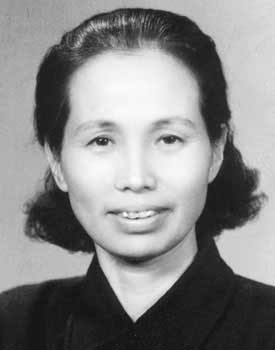Xie Xuehong facts for kids
Quick facts for kids
Xie Xuehong
|
|
|---|---|

Xie in 1952
|
|
| Chair of the Taiwan Democratic Self-Government League | |
| In office 1949–1958 |
|
| Preceded by | Position established |
| Succeeded by | Cai Xiao (1979) |
| Personal details | |
| Born |
Xie Shi Anu
17 October 1901 Shōka town, Shōka district, Taichū Prefecture, Taiwan, Empire of Japan (today Changhua City, Taiwan) |
| Died | 5 November 1970 (aged 69) Beijing, China |
| Citizenship | Empire of Japan (1901–1945) Republic of China (1945–1949) People's Republic of China (after 1949) |
| Political party | Taiwanese Communist Party (1928–1931) Chinese Communist Party (1948–1958) Taiwan Democratic Self-Government League (1947–1958) |
| Other political affiliations |
Taiwanese People's Party (1928–1931) |
| Xie Xuehong | |||||||
|---|---|---|---|---|---|---|---|
| Traditional Chinese | 謝雪紅 | ||||||
| Simplified Chinese | 谢雪红 | ||||||
|
|||||||
| Birth name | |||||||
| Traditional Chinese | 謝氏阿女 | ||||||
| Simplified Chinese | 谢氏阿女 | ||||||
|
|||||||
Xie Xuehong (Chinese: 謝雪紅; 17 October 1901 – 5 November 1970) was an important Chinese politician. She was born Xie Shi Anu. Xie was a strong supporter of women's rights. She helped start the Taiwanese Communist Party, which was active when Taiwan was ruled by Japan. Later, she moved to China. There, she became a member of the Taiwan Democratic Self-Government League and the Chinese Communist Party.
Contents
Early Life and Influences
Xie Xuehong was born in Changhua County, Taiwan, in 1901. Her family was working-class, and she was one of seven children. When she was twelve, she moved to live with another family. She later left this home to avoid an arranged marriage.
In 1918, Xie married Zhang Shumin. For a while, they lived in Kobe, Japan. During this time, Xie was influenced by the democratic ideas of the Taishō period. After moving to China, Xie and Zhang separated. Xie then started teaching sewing and selling clothes.
A Spark for Change
A big turning point for Xie was the May Fourth Movement in China. This movement was about patriotism and democracy. It inspired her to join Chiang Wei-shui's efforts to resist Japanese rule in Taiwan.
Xie studied sociology at Shanghai University. She also took part in the May Thirtieth Movement in 1925. This was a large anti-imperialist protest in China. In the same year, she was encouraged to join the Chinese Communist Party.
Studying Abroad and New Ideas
Xie then went to Moscow for more education. She studied for two years at the Communist University of the Toilers of the East. This experience further shaped her political views.
In November 1927, she returned to China. She began working to create the Taiwanese Communist Party (TCP). This party was officially founded in 1928. Xie and another person, Lin Mu-shun, recruited members for the TCP in Shanghai.
Leading and Facing Challenges
Xie's ideas spread to other groups. She took on leadership roles in Chiang Wei-shui's Taiwanese People's Party and the Taiwanese Cultural Association. Xie believed that keeping a unique Taiwanese identity was important. She also thought that people from all social classes should be involved in the movement.
However, not everyone agreed with her ideas. In 1931, she was removed from the Taiwanese Communist Party. Later that year, she was arrested for her political beliefs. She was sentenced to prison but was released in 1939 due to illness.
Return to Activism in Taiwan
Xie returned to political work in 1945. This was when Kuomintang forces arrived in Taiwan after World War II. Xie strongly believed that "Taiwan must be ruled by Taiwanese."
In September 1946, Xie started the Taiwan People’s Association. However, the Kuomintang government closed it down in January 1947. In 1947, she helped organize the 27 Brigade. She was also involved in the February 28 incident from her home in Taichung. During this time, she urged people not to damage property or hurt anyone.
Life in China and Legacy
Three weeks after the February 28 incident, Xie went to Hong Kong. There, she founded the Taiwan Democratic Self-Government League. This group opposed the idea of Taiwan becoming fully independent or a trusteeship. Instead, it supported freeing Taiwan from the control of Chiang Kai-shek and the Kuomintang.
Xie later moved to Xiamen, China. In China, she was active in the China Youth League. She also served on the Chinese People's Political Consultative Conference. This is an important political advisory body.
Later Challenges and Recognition
Xie continued to advocate for Taiwan's right to decide its own future. These views caused her problems with the Chinese Communist Party. During the Anti-Rightist Campaign in 1958, she faced difficulties. She was removed as leader of the Taiwan Democratic Self-Government League. She was also removed from the Chinese Communist Party and the National People's Congress.
Xie Xuehong passed away in Beijing in 1970. Years later, in 1986, the Chinese Communist Party officially recognized her contributions.

